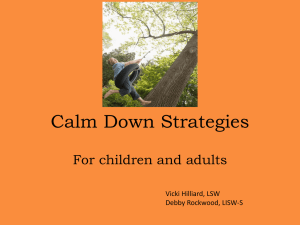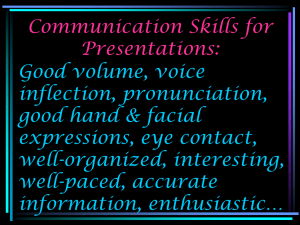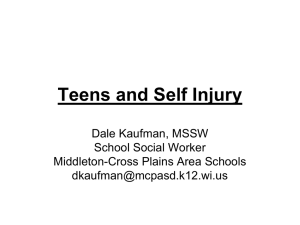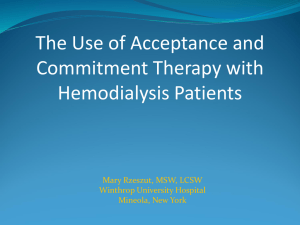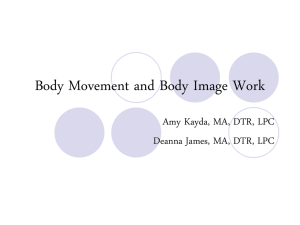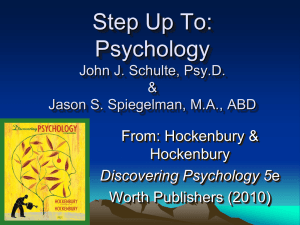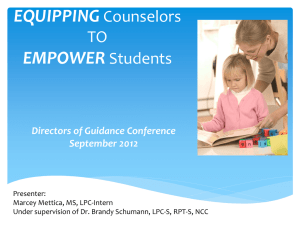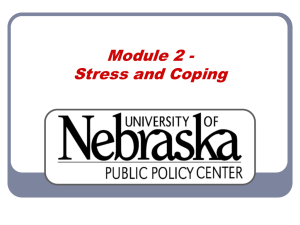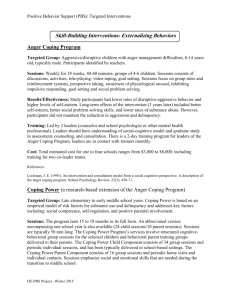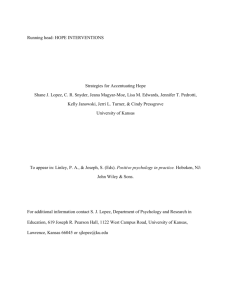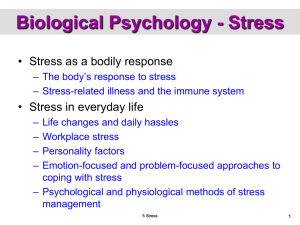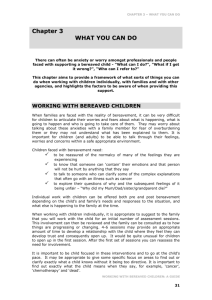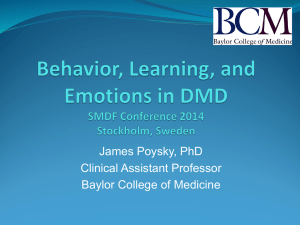Recovering Hope- - - Interventions that Help
advertisement
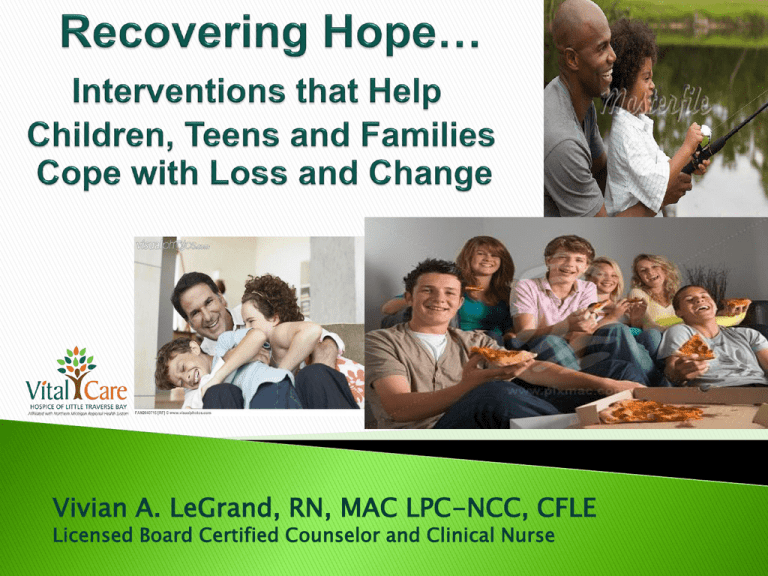
Vivian A. LeGrand, RN, MAC LPC-NCC, CFLE Licensed Board Certified Counselor and Clinical Nurse ● ● ● ● ● ● Recover hope and self-confidence Develop of sense of structure and safety Accept and embrace change Develop coping skills Management stress Increase personal insight and understanding of self and to identify personal strengths Help define who we are. Have a significant influence in our beliefs and in our values system. Create the type of person we dreamed we could be. We develop a mental picture of our world based on interactions with the persons we know and meet and the places where we live and visit. We also see ourselves through the eyes of other people. We as family members, parents, caregivers and providers can be most effective when we personally subscribe to the belief that life is good, for others, and for ourselves—this positive attitude is necessary for the healing process to begin. But we live in stressful times. Violence and unpredictable events pervade our life and our entire culture. No matter how hard you try, it seems like it’s just not hard enough. In 2006, 7.9 million U.S. children received emergency medical care for unintentional injuries (auto accidents, falls, fires, dog bites, near drowning, etc.) Over 400,000 of these injuries were due to violence. Race and ethnicity, poverty, and gender had a direct affect on the child or teen’s risk or likelihood of exposure to trauma. Significantly more boys than girls are exposed to traumatic community violence and serious injury. “There seeps in a gloomy sense that. . . It’s no use to set goals It’s no use in risking failure, again. And as a result, kids, parents, and families lose hope in their own ability to control their lives.” (David B. Feldman) “The reason we lose a lot of kids is they just kind of give up hope on themselves.” Psychologist, Dr. Robert J. Sternberg explains. Dr. Sternberg’s research found that a student’s ability or level of intelligence had little or no connection with this ominous outlook. With loss and change can come distress, despair and uncertainty. Severe loss and change can bring darkness, feelings of abandonment, helplessness, and hopelessness— And sometimes the loss of the “will” to care, survive or even live. Problems seem huge with no way out. Why…Children and teens are not as able as adults to express their emotions. In fact, they may not even realize that something is out of the ordinary. Why…Children and teens live in a world controlled by adults and can easily feel powerless over what is happening to them. Why…As caring adults, we can look for certain signs of trouble and help our children and teens to cope. The Basic 4 Categories: Emotional signs Cognitive signs (those involving thinking) Physical complaints Behavioral changes Important: Not everyone child or teen is going to experience every symptom. Sadness – feelings of despondency; hopeless; withdrawn. Loss of interest – rejects activities or hobbies that they have always enjoyed; overt feeling of boredom Anxiety – prolonged periods of anxiety, tension, irritability, and panic Turmoil – overly worried; brooding or lashing out in anger Persistent negative view of self with self-defeating, irrational thoughts. Difficulty organizing thoughts; problems in school; inability to complete homework or other tasks. Helpless and hopeless; feels that there is nothing they can do to relieve their sad or down feelings. Feelings of isolation; finds excuses to avoid engaging in usual activities with friends or family; spends more alone, sleeping, or isolating in bedroom. Worthlessness; obsessed over their perceived faults and failures; increased vulnerability to emotional abuse and being bullied. Weight gain or loss; incontinent of urine or feces Neglectful of physical appearance Sluggishness Depressed children often talk, react, and walk slower Less active and playful than their usual selves Sleep disturbances Difficulty falling asleep and staying asleep Experience intrusive thoughts or fears They may wake too early or oversleep Have trouble staying awake during the day at school Fear of the night Avoidance and withdrawal May withdraw from friends and family—TV, video games may become favorite activities for escape and solitude. Self-Harm Cause themselves physical pain or take excessive risks. Self-injury: scratching skin till it bleeds, pinching, hair pulling, extreme nail biting, cutting, alcohol, pills, and tobaccos. Restlessness May develop behaviors such as fidgeting, acting out in class, hypersensitivity or recklessness. Clinging and demanding May become more dependent on some relationships or behave with an exaggerated sense of insecurity. Consider “Best Practice”: Share and discuss any concerns you may have with parents or primary care givers. Most pediatricians and family practice providers recommend that parents schedule an appointment for their child or teen to have a complete physical exam and evaluation. Purpose: to rule-out any underlying physical problems that might further complicate the situation or the circumstances. Dr. C. R. Snyder conceptualized Hope as a vital cognitive foundation to any type of care model… Identifying Hope has long been recognized as an important component of successful psychosocial growth and change. Giving Hope is a central role of the provider in all aspects of physical and behavioral care. Energizing Hope is a necessary and crucial outcome to any care plan. The “Hope Theory” has led to the development of specific interventions designed to increase hope in clients by: …Dr. Snyder’s Hope Theory (Cheavens, Feldman, Woodward, & Snyder, 2006) Helping clients to identify low-elements and replace them with positive, hopeful thoughts. Eliciting hopeful cognitions and reducing distressful, negative, and irrational thought patterns. Assisting them to discover and utilize already-existing positive psychological coping skills and personal strengths/gifts. Facilitating in them a heightened level of confidence with which to apply these new strategies. Thereby, increasing personal well-being, self-esteem, resiliency, and a strong belief that they are capable of making Hopefulness Happen. Hope: fulfills our most basic human instincts to desire, with expectations, and receive what it is that we wish for and need to sustain our health and wellbeing. gives us confidence, trust and a strong belief that… what can be and what needs to be, most certainly will be! In order to recover hope, we must first know where to find it. It is present in everyone of us It is that child-like positive mental attitude that inspires within us a life-force to survive. At high enough levels, it helps move us beyond fear to imagine something greater is achievable. And yes, hope can be developed and nurtured. Overcoming fear and creating hope is necessary to our survival. Physiologically and psychologically, we are programmed and have the capacity to: Create and generate hope in ourselves and others. Nurture hope in its most abundant and loving form. Yes, it is possible to Restore Hope Simple yet effective interventions have been successful in restoring and rebuilding a level of hope that can: increase self-confidence reduce anxiety, fear and self-doubt normalize emotions/feelings and reduce guilt reframe hopeless & helpless into hopeful & helpful return laughter and seeing the brighter side of life 5 Interventions that help Recover Hope: No-Talk Therapy Learning to Relax Mandala Art Project for Coping with Change Making it Better—Activities for Children and Teens Living in a Stressful World Creative Journal Keeping In his book, Man’s Search for Meaning, Dr. Viktor Frankl, Holocaust survivor wrote: “Man…determines himself whether to give in to conditions or stand up to them. In other words, man is ultimately selfdetermining. Man does not simply exist, but always decides what his existence will be, what he will become in the next moment” (p. 206). Evander was the youngest of 9 children raised by Annie Laura, a single mom who worked cooking meals at a restaurant. He explained, “As a young man I could have gave up when things got tough, but my minister told me I was better than that—it all begins with that level of confidence and hope!” In conclusion, by assisting those we care for to regain a sense of hope we can assist and motive them to make positive changes in their lives. Utilizing “Hope Recovery Interventions” can assist children, teens and family members to reclaim confidence and selfdetermination to imagine the best possible life they could ever have! Believe in miracles and never give up hope— everyone deserves that kind of inspiration and personal regard. (photo by: Joan Sorenson, RN-Cheboygan, MI ) References Brazelton, T. B. (1984). To listen to a child. New York: Addison-Wesley Publishing Company. Conde-Frazier, E. (2011). Listen to the children: conversations with Immigrant families. Valley Forge: PA: Judson Press. Forman, S. G. (1993). Coping skills interventions for children and adolescents. San Francisco, CA: Jossey-Bass Publishers. Frankl, V. E. (2006). Man’s search for meaning. Boston, MA: Beacon Press. Gauding, M. (2009). One Million Mandalas. New York, NY: St. Martin’s Press. Heegaard, M. E. (1992). Drawing out feelings. Burnsvill, NC: Rainbow Collection & Compassion Books. References continued Hospice Foundation of America. (2008). Living with grief: children and adolescents. Oregon, IL: Quality Books Inc. Oehlberg, B. (1996). Making it better—activities for children living a stressful world. St. Paul, MN: Redleaf Press. Schoeneck, T. S. (1995). Hope for bereaved—understanding, coping and growing through grief. Syracuse, NY: Hope for Bereaved, Inc. Straus, M. B. (1999). No-talk therapy. New York, NY: w. W. Norton & Company, Inc.


